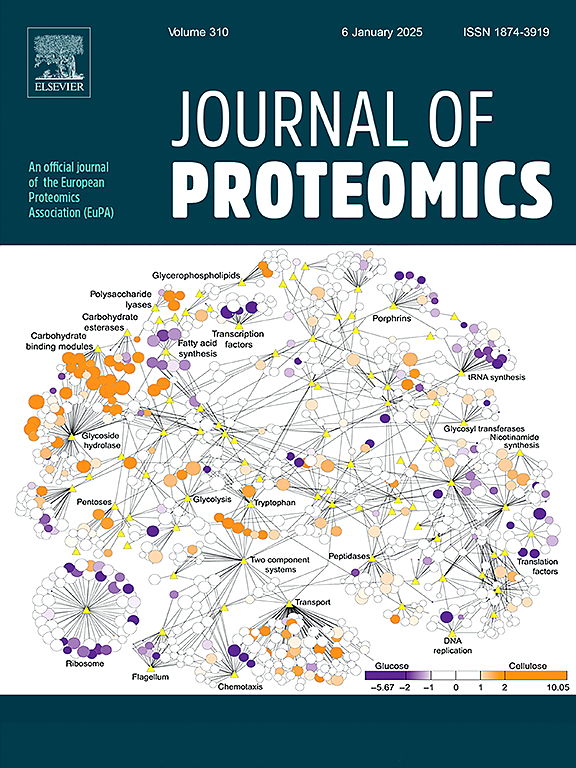Multi-organ proteome reveals different nursing ability between two honeybee srocks
IF 2.8
2区 生物学
Q2 BIOCHEMICAL RESEARCH METHODS
引用次数: 0
Abstract
High royal jelly production is an adaptive reproductive investment syndrome in honey bees that enhances their nursing ability to queen bee larvae. However, the biological basis of this reproduction investment at the multi-organ level remains elusive. In this study, proteome across 11 organs of two bee stocks: high royal jelly production bees (RJBs) and Italian bees (ITBs) was compared. Our analysis revealed significant differences in protein expression profiles in brain, fat body, mandibular gland, and Malpighian tubule, highlighting their crucial roles in regulating royal jelly secretion in RJBs. The increased energy turnover, protein synthesis, and lipid synthesis observed in RJBs compared to ITBs highlight their enhanced metabolic activity, which is essential for the robust secretion of royal jelly in RJBs. The elevated abundance of major royal jelly proteins (MRJPs), hexamerins, and vitellogenin suggests their critical contributions to the nutritional and material requirement necessary for royal jelly secretion. Furthermore, the high level of vitellogenin and juvenile hormone esterase may suppress juvenile hormones, which contribute to a strong royal jelly secretion and sensitivity of RJBs to larval pheromones relative to ITBs. This comprehensive dataset contributes to a better understanding of nursing behavior and reproductive investment in honey bees.
Significiance.
The royal jelly secretion syndrome is a colony level social trait dominated by the intricate interplay of multiple organs. However, previous studies have primarily focused on individual organs. In this study, the proteome of 11 organs was compared between high royal jelly production bees (RJBs) and Italian bees (ITBs) to provide knowledge on how multiple organs cooperate to boost the elevated royal jelly production by RJBs. Nutrition supply was sufficient at multiple organs of RJBs when compared to ITBs, indicating that nutrition plays an essential role in boosting energy metabolism, protein and lipid synthesis, and directly contributes to the amount of royal jelly secretion. The high level of secretion of storage proteins, such as MRJPs, hex, and vitellogenin, provides sufficient nutrition and material for royal jelly secretion. Moreover, the higher levels of vitellogenin and juvenile hormone esterase may suppress juvenile hormone synthesis, and contributing to stronger sense of RJBs to larval pheromone relative to ITBs. This suggests that nutrition can influence the hormone levels and sensory abilities of RJBs nurse bees to promote their royal jelly secretion ability. The reported data provide insights into the systematic regulation strategy of honeybee nursing behavior and reproductive investment.

多器官蛋白质组学揭示了两种蜜蜂岩石的不同护理能力。
蜂王浆高产是蜜蜂的一种适应性生殖投资综合征,增强了蜜蜂对蜂王幼虫的护理能力。然而,这种多器官水平的生殖投资的生物学基础仍然难以捉摸。本研究比较了高蜂王浆产量蜂(RJBs)和意大利蜂(ITBs)两种蜜蜂种群11个器官的蛋白质组学。我们的分析显示,脑、脂肪体、下颌骨腺和马尔比氏小管中的蛋白表达谱存在显著差异,突出了它们在调节rjb蜂王浆分泌中的重要作用。与ITBs相比,RJBs中观察到的能量转换、蛋白质合成和脂质合成增加,这表明RJBs的代谢活性增强,这对RJBs中蜂王浆的强劲分泌至关重要。蜂王浆主要蛋白(MRJPs)、六聚蛋白和卵黄原蛋白丰度的升高表明它们对蜂王浆分泌所需的营养和物质需求有重要贡献。此外,高水平的卵黄原蛋白和幼虫激素酯酶可能抑制幼虫激素的分泌,这是rjb分泌蜂王浆和对幼虫信息素敏感的原因。这个全面的数据集有助于更好地理解蜜蜂的护理行为和生殖投资。Significiance。蜂王浆分泌综合征是一种由多器官复杂相互作用支配的群居性社会性状。然而,以前的研究主要集中在单个器官上。本研究比较了高产蜂王浆蜜蜂(RJBs)和意大利蜂(ITBs) 11个器官的蛋白质组学,以了解RJBs如何协同促进高产蜂王浆的产生。与ITBs相比,RJBs的多器官营养供应充足,说明营养在促进能量代谢、蛋白质和脂质合成方面起着重要作用,并直接影响蜂王浆的分泌量。大量分泌MRJPs、hex、卵黄原蛋白等贮藏蛋白,为蜂王浆分泌提供了充足的营养和物质。此外,较高水平的卵黄原蛋白和幼鱼激素酯酶可能抑制幼鱼激素的合成,导致RJBs对幼虫信息素的感知较ITBs强。这说明营养可以影响rjb护理蜂的激素水平和感觉能力,从而促进其分泌蜂王浆的能力。这些数据为研究蜜蜂的护理行为和生殖投资的系统调控策略提供了新的思路。
本文章由计算机程序翻译,如有差异,请以英文原文为准。
求助全文
约1分钟内获得全文
求助全文
来源期刊

Journal of proteomics
生物-生化研究方法
CiteScore
7.10
自引率
3.00%
发文量
227
审稿时长
73 days
期刊介绍:
Journal of Proteomics is aimed at protein scientists and analytical chemists in the field of proteomics, biomarker discovery, protein analytics, plant proteomics, microbial and animal proteomics, human studies, tissue imaging by mass spectrometry, non-conventional and non-model organism proteomics, and protein bioinformatics. The journal welcomes papers in new and upcoming areas such as metabolomics, genomics, systems biology, toxicogenomics, pharmacoproteomics.
Journal of Proteomics unifies both fundamental scientists and clinicians, and includes translational research. Suggestions for reviews, webinars and thematic issues are welcome.
 求助内容:
求助内容: 应助结果提醒方式:
应助结果提醒方式:


